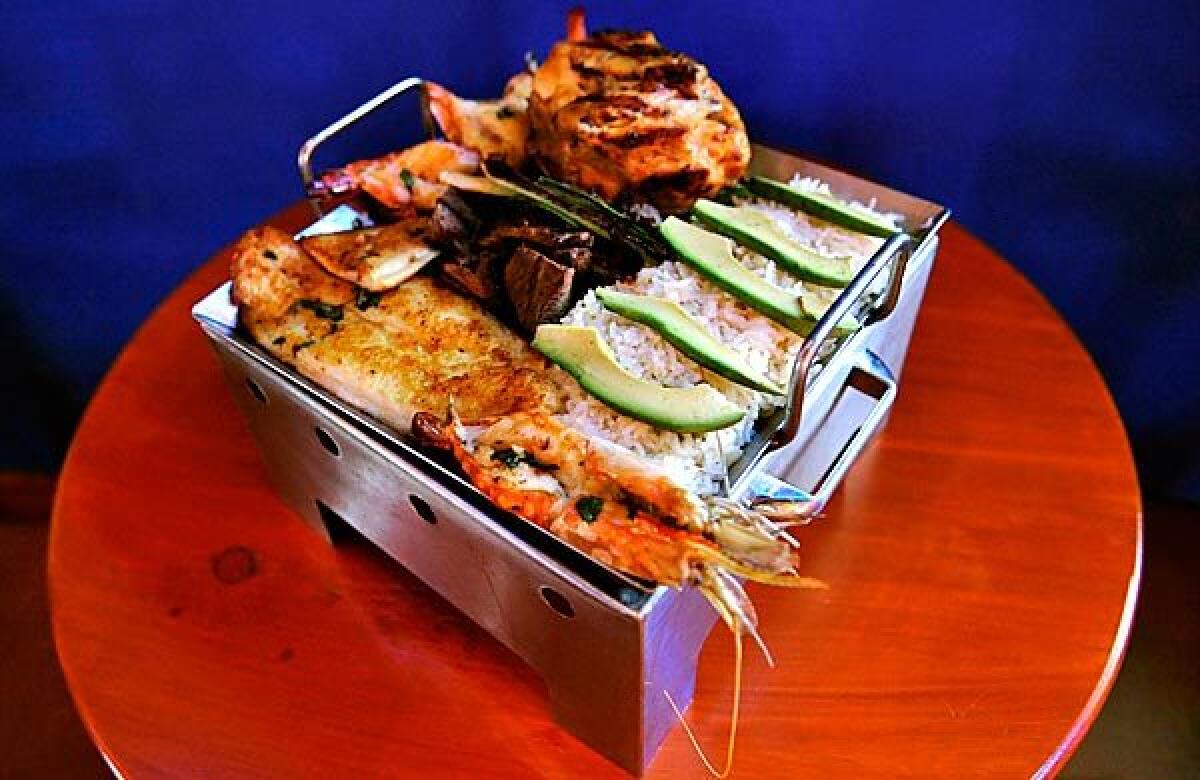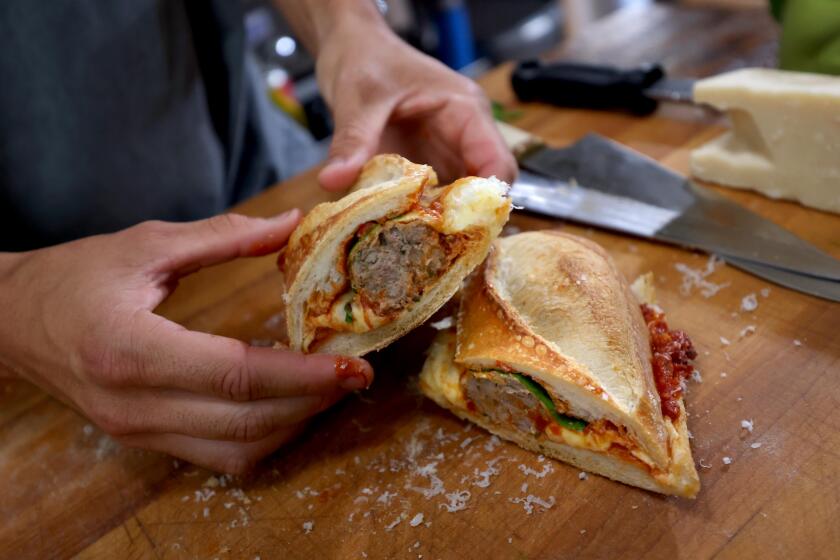A fuller flowering of Salvadoran flavors

A foodie rite of passage here in Los Angeles is to walk the pupusa mile: that stretch of Beverly Boulevard where Koreatown’s northeastern fringe pans to a scramble of auto services, a hostess club or two, and Central American restaurants and bakeries. This is the old-guard Salvadoran restaurant row, but these days a new wave of restaurants is revealing a wealth of regional dishes beyond that well-trod corridor.
The pupusa may be El Salvador’s national dish, but Sonsonate Grill, El Santiagueño and Mis Raices, located in two lesser-known Salvadoran enclaves — between the Vernon-Main neighborhood and Jefferson Park in central L.A., and an area straddling Lake Balboa and Van Nuys in the San Fernando Valley — are showcasing recipes worthy of their greatest culinary symbol, the delectable izote flower.
Here you can find yuca (cassava) covered with curtido (pickled cabbage) and fried baby sardines, pacaya rellena (bamboo shoots stuffed in an egg batter) or a sopa de arroz aguado, a simple rice-and-chicken soup stimulated by the pungent chipilin herb.
Ingredients have become more widely available in local markets, such as the Salvadoran-owned Liborio market chain. And families now visit El Salvador frequently, searching for new recipes; this wasn’t the case during that country’s civil war from 1979 to 1992 and its subsequent reconstruction.
Ruben Laguardia’s 3-month-old Sonsonate Grill (which has a sister restaurant on Western Avenue) is the most luxurious Salvadoran restaurant experience in Los Angeles — in the unlikeliest of neighborhoods. Vernon-Main is a drab parcel just east of the 110 Freeway between South Los Angeles and the USC campus. Sculpted metal troubadours greet patrons outside, and the interior is West Hollywood-esque beach cantina.
Laguardia comes from the department (the Salvadoran equivalent of a state) of Sonsonate and took over the erstwhile Mexican restaurant La Canoa, which had been newly refurbished: “I didn’t have to change very much, but I’m from this neighborhood, and I want to set an example for the others to follow here,” Laguardia says.
Sonsonate Grill serves national Salvadoran cuisine and a variety of seafood dishes and surf and turf from the coastal city of Acajutla. Salvadoran beers, the Regia, Suprema or Pilsener, go along with a parrillada Salvadoreña: a well-seasoned filet of carne asada, tender tilapia, perfectly cooked shrimp and a grilled quarter-chicken all served on a brazier with fluffy white rice, sliced avocado, a side of salad and beans whose flavors have been deepened by scorched onion.
But the pan con gallina might be the star of the restaurant: a mouth-watering chicken sandwich on French bread with a salad of mayo and peppers, and a surprising requisite ingredient: watercress, and lots of it. It’s a heaping sandwich served with a side of carne guisada, a savory tomato-based stew also available as a main course.
Sonsonate may be lavish and new, but more quietly Ana Velasquez has been leading a Salvadoran gourmet movement at her 9-year-old El Santiagueño — a sunny patio tucked into a parking lot on South San Pedro Street. Everything is cooked to order from recipes brought back from Ana’s hometown, Atiquizaya, in the department of Ahuachapán.
Ahuachapán has one of the great culinary traditions of El Salvador: Cooks are skilled in soups and stews (not to mention desserts). “I’m always trying to bring back recipes. My sister sends them from our town, where we are known for having more of a variety of dishes than other towns,” Velasquez says.
Start with some pastelitos de carne, Salvadoran beef turnovers with tasty shell and filling alike, the other masa-based antojito from El Salvador, besides the pupusa.
The sopa de pescado, fish soup, is a testament to the fine cooking at El Santiagueño. A catfish head and tail are cooked in a rich broth of red and green bell peppers known as chiles dulces, onions, cilantro, herbs and a splash of Salvadoran cream. This slow-cooked fish soup hints at Southeast Asian cookery without the heat.
El Santiagueño’s sopa de pata, a soup of beef foot and tripe with cabbage, yuca, corn and squash that have all been carefully cooked, attains a freshness not found in any local Mexican menudos. Light and subtle, it’s a sublime bowl of Salvadoran comfort.
Even her pacaya, palm flowers cooked in the typical style of a relleno, fried in an egg batter and then topped by a tomato sauce, is extraordinary. Most Salvadoran cooks use more egg, but Velasquez lets the bitter strands of pickled, corn-like pacaya stand out, and the sauce: “I put just a bit of guajillo chile for flavor, but not spicy,” Velasquez says.
If Mexico’s taste is spicy, then El Salvador’s leans toward the bitter. The pacaya, along with various flowers and herbs that distinguish Salvadoran cooking, all share this quality.
In addition to the pacaya, chipilin herb and loroco, the edible flower served in pupusas, there are the pito and mora flowers, and the national flower of El Salvador, the flor de izote, locally known as the spineless yucca — all part of the Salvadoran kitchen.
In Lake Balboa, another local Salvadoran enclave, Mercedes Rodriguez’s Mis Raices, serves pitos con huevo (a dish that might make a Mexican teenager snicker), the red pito flower cooked with eggs. Amazingly, the pito tastes like a pungent sausage. Pito also comes in alguaishte, a traditional Salvadoran sauce made from ground squash seeds, similar to a home-style Mexican mole.
Rellenos are here too, such as the güisquil, what Salvadorans call the chayote: mixed with cheese, fried in an egg batter, topped with a tomato sauce and served alongside well-seasoned refried red beans and rice. Rodriguez isn’t afraid of big flavors.
At $5.99, the fritada is a steal: pig heart, ears, cheeks, tongue and liver are blanched then sautéed in tomato and yerba buena (mint) and bell pepper, giving it a sweet herbal kiss.
And the flor de izote? “Friends always bring it to me from my hometown, Quezaltepeque, La Libertad,” says Rodriguez.
It also grows wild in Pasadena and is a common garden plant there. In the summer, when an illicit trade in spineless yucca booms in the Salvadoran community around MacArthur Park, the white national flower of El Salvador will show up on the tables of home kitchens and in some tamales on the streets of Westlake. If you can’t cop them in MacArthur Park, you could always try to grow your own — we hear the plants are available at IKEA.
El Santiagueño
LOCATION: 1939 S. San Pedro St., Los Angeles; (213) 745-8001
PRICES: Appetizers, $1.99 to $4.99; entrees, $5.99 to $14.99; pupusas, $1.75
DETAILS: Open 10 a.m. to 9 p.m. Monday to Friday; 9 a.m. to 8 p.m. Saturday and Sunday. Soft drinks, aguas frescas. Lot parking.
Mis Raices
LOCATION: 7539 Reseda Blvd., Reseda; (818) 708-1205
PRICES: Appetizers, $1.50 to $3.99; entrees, $5.50 to $8.50; pupusas, 99 cents on Tuesdays and Wednesdays
DETAILS: Open 8 a.m. to 10 p.m. daily. Soft drinks, aguas frescas. Street parking.
Sonsonate Grill
LOCATION: 4350 S. Avalon Blvd., Los Angeles; (323) 233-1333
PRICES: Appetizers, $2.50 to $7.95; entrees, $9.95 to $16.95; parrillada for two, $29, for four, $39; pupusas, $2.25 to $2.95
DETAILS: Open 9 a.m. to midnight daily. Soft drinks, aguas frescas, beer and wine. Lot parking.
More to Read
Eat your way across L.A.
Get our weekly Tasting Notes newsletter for reviews, news and more.
You may occasionally receive promotional content from the Los Angeles Times.









